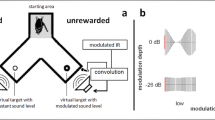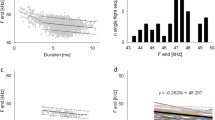Summary
Hipposideros ruber use CF/FM echolocation calls to detect the wing flutter of their insect prey. Fluttering prey were detected whether the insects were flying or sitting on a surface, and prey in either situation were captured with equal success (approximately 40% of capture attempts). Stationary prey were ignored. The bats did not use visual cues or the sounds of wing flutter to locate their prey. Wing flutter detection suggests that H. ruber exploit the Doppler-shifted information in echoes of their echolocation calls. These bats fed primarily upon moths, usually those of between 10 and 25 mm wingchord, although moths of less than 5 mm and greater than 40 mm wingchord were also attacked and captured. They showed no evidence of selecting moths on the basis of species or other taxonomic distinction, and occasionaly captured other insects.
Similar content being viewed by others
References
Bell GP (1982a) Prey location and sensory ecology of two species of gleaning, insectivorous bats, Antrozous pallidus (Vespertilionidae) and Macrotus californicus (Phyllostomatidae). PhD thesis, Carleton University, Ottawa
Bell GP (1982b) Behavioral and ecological aspects of gleaning by a desert insectivorous bat, Antrozous pallidus (Chiroptera: Vespertilionidze). Behav Ecol Sociobiol 10:217–223
Belwood JJ, Fenton MB (1976) Variation in the diet of Mytois lucifugus (Chiroptera: Vespertilionidae). Can J Zool 54:1674–78
Brown PL, Berry RD (1983) Echolocation behavior in a “flycatcher” bat, Hipposideros diadema. Acoust Soc Am (Suppl. I) 74:532
Buchler ER (1976) A chemiluminescent tag for tracking bats and other small nocturnal mammals. J Mammal 57:173–176
Cumming DHM (1975) A field study of the ecology and behaviour of the warthog. Mus Mem 7, Trustees Nat Mus Mon Rhodesia, Salisbury
Fenton MB (1982) Echolocation, insect hearing, and the feeding ecology of insectivorous bats. In: Kunz TH (ed) Ecology of bats. Plenum Press, New York, pp 261–285
Fenton MB (1984) Echolocation: implications for the ecology and evolution of bats. Q Rev Biol 59:33–53
Fenton MB, Bell GP (1981) Recognition of species of insectivorous bats by their echolocation calls. J Mammal 62:233–243
Fenton MB, Fullard JH (1979) The influence of moth hearing on bat echolocation strategies. J Comp Physiol 132:77–86
Fenton MB, Gaudet CL, Leonard ML (1983) Feeding behaviour of the bats Nycteris grandis and Nycteris thebaica (Nycteridae) in captivity. J Zool (Lond) 200:347–354
Fiedler J (1979) Prey catching with and without echolocation in the Indian false vampire (Megaderma lyra). Behav Ecol Sociobiol 6:155–160
Fullard JH (1982) Echolocation assemblages and their effects on moth auditory systems. Can J Zool 60:2572–2576
Fullard JH, Thomas DW (1981) Detection of certain African, insectivorous bats by sympatric, tympanate moths. J Comp Physiol 143:363–368
Goldman LT, Henson OW (1977) Prey recognition and selection by the constant frequency bat, Pteronotus parnellii parnellii. Behav Ecol Sociobiol 2:411–420
Griffin DR, Simmons JA (1974) Echolocation of insects by the horseshoe bats. Nature 250:731–732
Hayman RE, Hill JE (1971) Order Chiroptera. In: Meester J, Setzer HW (eds) The mammals of Africa; an identification manual, part 2. Smithsonian Institution, Washington, DC, pp 1–73
Jen PH-S, Suthers RA (1982) Responses of inferior colliculus neurones to acoustic stimuli in certain FM and CF-FM palaeotropical bats. J Comp Physiol 146:423–424
Kelly MS (1983) The role of vision in prey location in the Indian false vampire bat (Megaderma lyra). BSc thesis, Carleton University
Kunz TH, Whitaker JO Jr (1983) An evaluation of fecal analysis for determining food habits of insectivorous bats. Can J Zool 61:1317–1321
McCue JJG, Bertolini A (1964) A portable receiver for ultrasonic waves in air. Trans IEEE Sonics Ultrasonics SU 11:41–49
Neuweiler G (1980) How bats detect flying insects. Physics Today 33(8):34–40
Novick A (1977) Acoustic orientation. In: Wimsatt WA (ed) Biology of bats, vol 3. Academic Press, New York, pp 73–289
Rabinowitz AR, Tuttle MD (1982) A test of the validity of two currently used methods of determining bat prey preferences. Acta Theriol 27:283–293
Roeder KD (1967) Nerve cells and insect behavior, revised edn. Harvard University Press, Cambridge, Mass
Schnitzler H-U (1968) Die Ultraschallortungslaute der Hufeisenfledermäuse in verschidenen Ortungssituationen. Z Vergl Physiol 57:376–408
Schnitzler H.-U, Menne D, Kober R, Heblich K (1983) The acoustical image of fluttering insects in echolocating bats. In: Huber F, Markl H (eds) Neuroethology and behavioral physiology Springer, Berlin Heidelberg New York, pp 235–250
Schuller G, Pollak G (1979) Disproportionate frequency representation in the inferior colliculus of Doppler-compensating greater horseshoe bats: evidence for an acoustic fovea. J Comp Physiol 132:47–54
Simmons JA, Stein RA (1979) Acoustic imaging in bat sonar: echolocation signals and the evolution of echolocation. J Comp Physiol 135:61–84
Simmons JA, Fenton MB, Ferguson WR, Jutting M, Palin J (1979) Apparatus for research on animal ultrasonic signals. Life Sci Misc Publ, Royal Ontario Mus, pp 1–31
Trappe M, Schnitzler H-U (1982) Doppler-shift compensation in insect-catching horseshoe bats. Naturwissenschaften 69:193–194
Tuttle MD, Ryan MJ (1981) Bat predation and the evolution of frog vocalizations in the neotropics. Science 214:677–678
Vaughan TA (1976) Noctural behavior of the African false vampire bat (Cardioderma cor). J Mammal 57:227–248
Vaughan TA (1977) Foraging behavior of the giant leaf-nosed bat (Hipposideros commersoni). E Afr Wildl J 15:237–249
Vogler B, Neuweiler G (1983) Echolocation in the noctule (Nyctalus noctula) and horseshoe bat (Rhinolophus ferrumequinum). J Comp Physiol 152:421–432
Werner TK (1981) Responses of nonflying moths to ultrasound: the threat of gleaning bats. Can J Zool 59:525–529
Author information
Authors and Affiliations
Rights and permissions
About this article
Cite this article
Bell, G.P., Fenton, M.B. The use of Doppler-shifted echoes as a flutter detection and clutter rejection system: the echolocation and feeding behavior of Hipposideros ruber (Chiroptera: Hipposideridae). Behav Ecol Sociobiol 15, 109–114 (1984). https://doi.org/10.1007/BF00299377
Received:
Accepted:
Issue Date:
DOI: https://doi.org/10.1007/BF00299377




